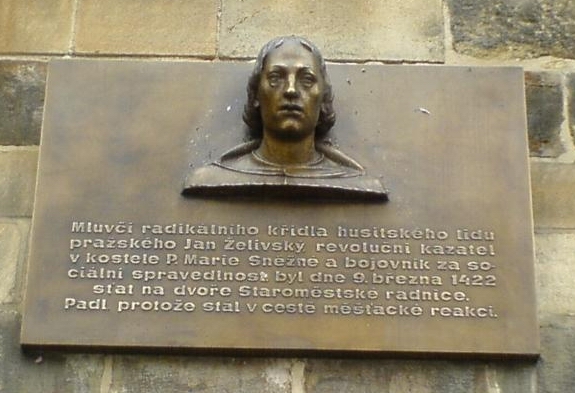The Hussite Movement and the 15th Century
A structure with a nave and two side aisles was added on to the existing presbytery, with the plan that the church would have a total length of 110 metres. Work progressed furthest on the north aisle, which seems to have been completed. Better preserved today, however, is the wall of the south aisle with its gothic windows, which can be seen in the attic of the monastery. In 1405 work seems to have been completed on a "tall and beautiful tower" on the north side in the direction of the Old Town. It contained a large bell known as "Charles" or "indefatigable". Work was started on a corresponding tower on the south side, but this project was soon abandoned.
Soon after this the first signs of the Hussite movement began to make themselves felt. As early as 1412 the monastery was attacked and looted, with Jeroným of Prague, a leading supporter of Jan Hus, playing an active role. It is recorded that "in the monastery of Our Lady on the Sand in Prague, he took the relics from the altar, threw them into the mud, and trampled on them". The unrest was repeated in 1415. On 25 February 1419 King Václav IV allowed the Hussites to hold services, preach, sing Czech hymns, and distribute communion under both kinds in the church of Our Lady of the Snows and in two other churches near the border between the Old and New Towns, St. Ambrose and St. Benedict. This course of events meant that the church of Our Lady of the Snows became the centre of the most radical Hussites, and the turbulent preacher Jan Želivský, originally a Premonstratensian priest from the monastery in Želiv, stablished himself there.
 On 30 July 1419, at a time of great tension, a procession was planned to take place in the New Town. After a fiery sermon, Želivský led the procession, with a monstrance at its head, to the church of St. Stephen. They returned to Our Lady of the Snows across the New Town marketplace, passing by the town hall. Here a conflict broke out with the councillors, and the crowd took the town hall by storm. The councillors were seized and thrown out of the windows onto the square, where they were beaten to death. This event, known as the first Prague defenestration, was the start of the difficult period of the Hussite wars in Bohemia.
On 30 July 1419, at a time of great tension, a procession was planned to take place in the New Town. After a fiery sermon, Želivský led the procession, with a monstrance at its head, to the church of St. Stephen. They returned to Our Lady of the Snows across the New Town marketplace, passing by the town hall. Here a conflict broke out with the councillors, and the crowd took the town hall by storm. The councillors were seized and thrown out of the windows onto the square, where they were beaten to death. This event, known as the first Prague defenestration, was the start of the difficult period of the Hussite wars in Bohemia.
After the death of King Václav IV on 16 August 1419 the Hussites began to plunder the churches and monasteries in Prague. The monastery of Our Lady of the Snows was attacked on 20 August and some of the monks were captured. The extent of the damage caused is unclear. At all events, it marked the definitive end of the construction of the nave. The abandoned monastery was administered by the council of Prague New Town.
Difficult times continued for the monastery even after the death of Želivský, whose militant radicalism proved fatal for him, and who was executed in the Old Town Hall on 9 March 1422 and buried in Our Lady of the Snows beneath where the pulpit was at the time. In 1434 what was effectively a civil war broke out between the Old Town and the New Town. The conflict ended with the victory of the Old Town party. During the fighting an important role was played by the northern "tall and beautiful tower", which was a convenient strategic location for bombarding the Old Town. It was from here, too, that the New Town party sounded the alarm by ringing the large bell there. The tower therefore became the target of artillery fire from the Old Town, and eventually the bell was shot down. During a subsequent attack the entire tower was demolished.
A smaller number of Carmelites were able to return to their monastery in 1435, when they renovated the church. However, during the plague in the reign of Vladislav II, rioting started again in September 1483, and the Carmelites once again fled from Prague. The mob knocked the heads off the relief that was then positioned above the monastery gate. The Carmelites returned again in 1496, but even then the times were turbulent and uncertain, and it was not possible to continue with building work.






